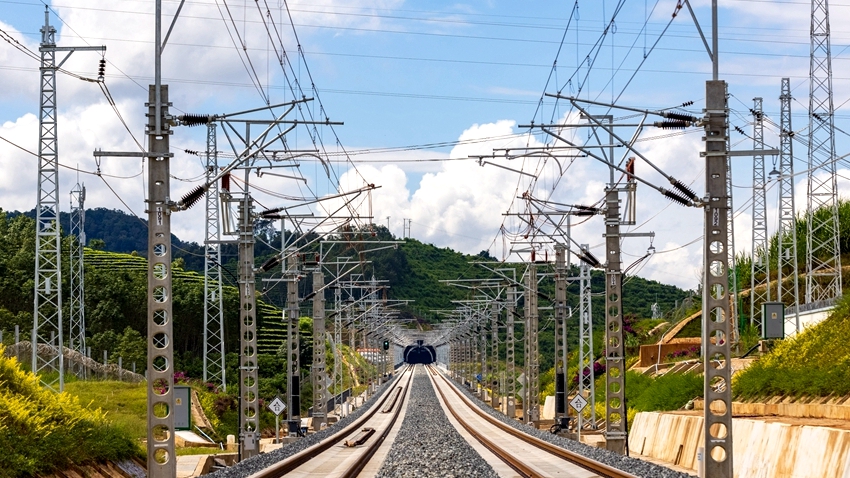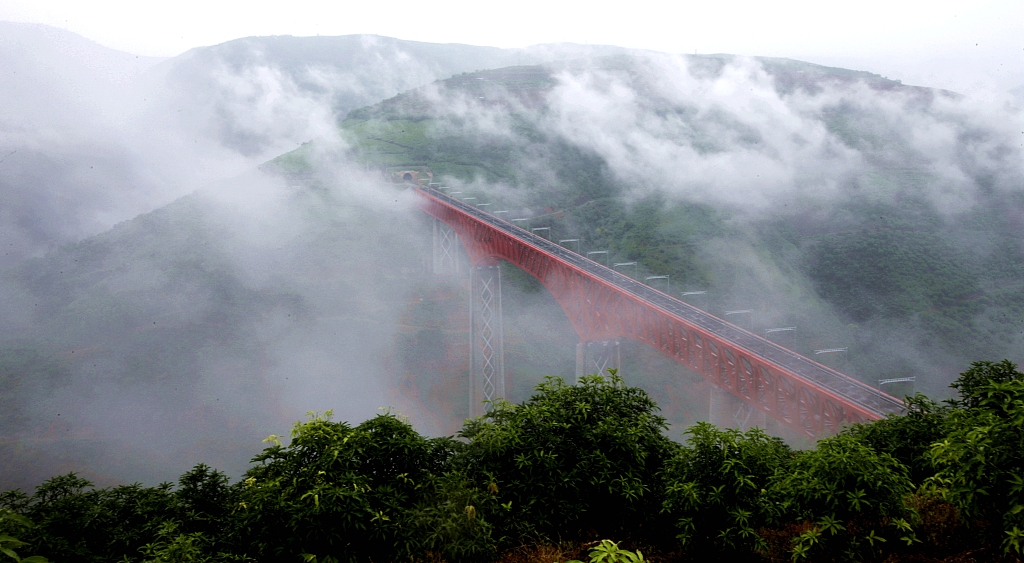
A section of the China-Laos railway in Xishuangbanna Dai Autonomous Prefecture, Yunnan Province, southwest China, September 28, 2021. /Xinhua
A section of the China-Laos railway in Xishuangbanna Dai Autonomous Prefecture, Yunnan Province, southwest China, September 28, 2021. /Xinhua
Editor's note: Stephen Ndegwa is a Nairobi-based communication expert, lecturer-scholar at the United States International University-Africa, author and international affairs columnist. The article reflects the author's opinions and not necessarily the views of CGTN.
Some people may have not heard of Laos, a landlocked country located in Southeast Asia. Well, you cannot blame them. The country is among a group of many such countries that are yet to open up fully.
But China's game-changing Belt and Road Initiative (BRI) has transformed all that for Laos with the recent completion of the over-1,000-kilometer-long cross-border railway connecting the city of Kunming in southwest China's Yunnan Province with Vientiane, Laos' capital city. With otherwise known as the "China-standard" bullet train or Electric Multiple Unit (EMU) train, the railway line was officially delivered to the Laos-China Railway Co., Ltd on October 16 to await its official launch this month.
Officially the Lao People's Democratic Republic, Laos has several similarities with China. The two countries are also socialist states, a governance system that puts people's welfare first above other considerations. The two countries have both experienced colonization.
Economically, China and Laos are members of the Asia-Pacific Trade Agreement, the oldest preferential trade agreement between countries in the region. Both also belong to the East Asia Summit, a regional platform that comprises 18 countries in the East Asian, Southeast Asian, South Asian and Oceanian regions, besides Russia and the U.S. Naturally, the two developing countries are members of a few global organizations like the World Trade Organization and the United Nations.
In addition to offering Laos a vast global platform based on the principles of extensive consultation, joint contribution and shared benefits, the China-Laos railway is huge on several fronts. First, to those who do not see the potential of such a massive project in that part of the world, there is a financial risk for both partners. People normally expect such projects to be constructed in places with current economic might in order to shorten the break-even period.
But as a developing country, China is empathetic to Laos' economic situation and understands that potential is exploited and grown, no matter how insignificant it appears. Indeed, the railway is a precious opportunity, coming at a time when Laos is striving to rise from the impact of the COVID-19 pandemic.
According to the World Bank's "Economic Monitor for Lao PDR: A Path to Recovery," Laos' gross domestic product will grow to 3.6 percent in 2021, against a paltry 0.5 percent last year. With the current outlook, the prospects for 2022 can get better if the contribution of the BRI China-Laos railway project is factored into the equation.

The Yuanjiang Railway Bridge on the China-Laos railway in Yuxi, Yunnan Province, southwest China, October 6, 2020. /VCG
The Yuanjiang Railway Bridge on the China-Laos railway in Yuxi, Yunnan Province, southwest China, October 6, 2020. /VCG
The railway project will be handy in supporting Laos' growth drivers, including agriculture and manufacturing exports. Tourism, hospitality and transport are also other sectors that will benefit immensely from the railway.
This analysis is in line with a World Bank study released in June 2019 titled "Belt and Road Economics: Opportunities and Risks of Transport Corridors," which observed that BRI transport projects can expand trade, increase foreign investment, and reduce poverty as a result of lowering trade costs. Globally, according to the report, completed BRI transport projects could increase trade between 1.7 percent and 6.2 percent for the world, and increase global real income by 0.7 percent to 2.9 percent.
Recent global challenges have also led China to put some value addition to BRI by incorporating information, communication and technologies in the project. Just like the physical infrastructure projects are essential in the movement of people and goods, digital communication channels are also an essential part in achieving BRI objectives and beyond.
Digitization of the BRI will open up the information superhighway by enhancing the availability and affordability of internet and broadband networks. Further, this will make digital inclusion a reality, therefore helping in the achievement of the UN's Sustainable Development Goals.
The direction agrees with China's recent application to join the Digital Economy Partnership Agreement (DEPA) with the aim of strengthening international cooperation on the digital economy. It is important to note that signatories to the June 12, 2020, DEPA pact – Singapore, New Zealand and Chile – are all members of the BRI.
Ultimately, BRI is not just an infrastructural project. Laos is now part of a comprehensive global network that brings together all the participating countries across almost all continents. The project will now increase Laos' chances of international cooperation with its mutual benefits of give and take among partners.
Nothing represents better the ideal of a shared future for humanity than the all-encompassing BRI with its vast socio-economic tentacles. The connectivity, both physical and virtual, is tailored in a way that means no one in the network will be left behind.
(If you want to contribute and have specific expertise, please contact us at opinions@cgtn.com.)

